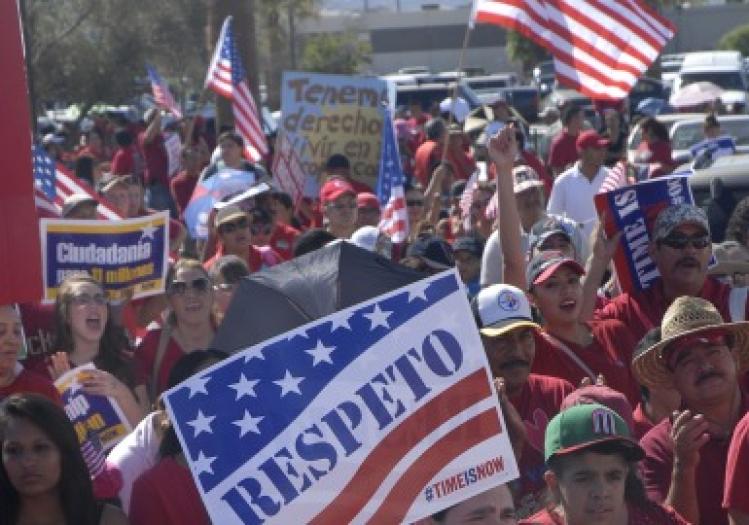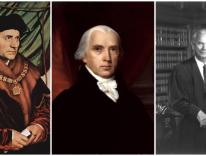
Every four years our presidential elections, depressing though they may be, provide a fascinating view of American society. The 2012 election—blessedly behind us—revealed a starkly polarized America. Before the next round begins, it is worth considering what we as Catholics might do to counter the polarizing trends that threaten our ability to come together and act as one people.
An analysis of the election results by pollster extraordinaire Nate Silver found that in 2012 a large majority of congressional districts (242) were landslide districts—places where Obama got more than 73 percent of the vote or Romney got more than 67 percent (i.e., a difference of more than 20 percentage points from the national average). Only thirty-five were swing districts, in which the vote more or less reflected the overall national vote. The landslide districts, which have been steadily growing in number for two decades, are increasingly homogeneous politically—and their representatives in Congress act accordingly. Elected by firmly partisan constituencies, they see no need to compromise; indeed, they fear primary challenges if they deviate from the party line or work with members of the other party.
This electoral polarization makes it nearly impossible for Congress to do the nation’s business, as the recent government shutdown once again demonstrated. We now routinely suffer self-imposed budget and fiscal crises of one sort or another. Budgets are cut or extended stupidly, with little or no reasonable judgment of priorities. Presidential appointments are held up endlessly, leaving the federal government without effective management. Important legislation to deal with a still-faltering economy, a crumbling infrastructure, rampant poverty, and a broken criminal-justice system dies in committee or by filibuster.
Part of this increase in political polarization results from redistricting by state legislatures, which are ever more adept at drawing district maps that assist the dominant party in winning the maximum possible number of congressional seats. But it also reflects increasing polarization and division along other dimensions, most notably income and wealth. It is well documented that economic inequality in the United States is at its highest point since the 1920s. Both wealth and poverty are geographically concentrated: the poor live disproportionately in inner-city neighborhoods and some rural pockets, while the rich live mostly in affluent suburbs. One study found that the proportion of families living in middle-income neighborhoods fell by a third between 1970 and 2007, while that of families living in either very rich or very poor neighborhoods doubled to more than 30 percent.
Another study describes a “great divergence” between those cities and regions with high concentrations of educated workers and those without. The places where highly educated workers live possess higher income and provide enhanced opportunities for children, which boost social divergence over generations. These hubs of educational concentration are increasingly more privileged than the rest of the country, with better health, longer life expectancy, and stronger families. The urban-studies theorist Richard Florida has described the growth of cities and neighborhoods within cities that are home to an increasingly well-educated and affluent “creative class.” A politically controversial but factually astute book by Charles Murray, Coming Apart (2012), describes the differences between “Belmont,” home to the affluent and educated classes, and “Fishtown,” home to the poorer and less educated. These two communities diverge in rates of marriage, divorce, unmarried parenthood, employment, obesity, health, and politics. Murray paints a picture of two Americas, one affluent and becoming more so, one poor and stagnating.
TAKEN TOGETHER, THESE studies reveal a deeply divided America in which members of different “tribes” live separately from one another. One tribe is increasingly privileged and able to pass on its privileges to its children through excellent schools, material comfort, and out-of-school activities presided over by two secure parents. The other tribe is increasingly disadvantaged, with poor education leading to poor employment prospects and unstable families, bringing predictable consequences for children. Because the two groups typically live in different neighborhoods and even different cities and regions, they seldom interact, diminishing the sense of a shared American destiny and making it even more difficult to effect policies that might decrease inequality and increase opportunity.
Religious affiliation and attendance also separate the tribes. Most Americans describe themselves as religious and attend services at least a few times a year. Religious communities are the most frequent recipients of charitable giving and volunteering; for many Americans they are important sources of friendships and networks. They also guide political values and preferences—not so much via overt politicking in church but rather through the interaction and conversation they promote among fellow believers. How religious communities are structured, what they preach, and what they do are all potentially important in shaping our society.
The biggest change in the American religious landscape over the past few decades has been the growth in the percentage of people—almost 20 percent in the most recent polls—who identify themselves as nonreligious or religiously unaffiliated. In an interesting and somewhat unexpected twist, religious affiliation and attendance have stayed stable or increased slightly among the college educated, while decreasing among the less well educated, the unmarried, and the unemployed. Those who are disconnected and disadvantaged economically and socially have also dropped out of religious life. We know that membership in a congregation brings socioeconomic as well as spiritual benefits: the development of social and leadership skills, the building of networks useful in finding work and easing the strains of family life. To the extent, then, that the disadvantaged and disconnected are leaving or being pushed out of congregational life, the trend may be reinforcing inequality in other dimensions.
Meanwhile, those who do go to church tend to go with people like themselves. Martin Luther King famously described eleven o’clock on Sunday morning as “the most segregated hour of Christian America,” and that description remains true—economically as well as racially. Catholic parishes historically are geographically based; and to the extent that the general population is sorted geographically by income and education, so too are Catholic parishes. And as Catholics increasingly feel free to shop for a congenial parish, not confining themselves to the church in their neighborhood, anecdotal evidence suggests that they cluster into parishes of the theologically and politically like-minded—into “social-justice parishes” or “prolife parishes.” Although Catholics divide almost evenly between Republican and Democratic voters in presidential elections, I suspect that the typical parish does not divide evenly, but instead votes disproportionately for one party or the other. In Catholic parishes, then, as in the general society, income differences, educational differences, lifestyle differences, and political differences reinforce one another.
Yet another trend in American religious life may be at least slightly countering increased inequality and class segregation. Religiously affiliated Americans today are worshipping in larger and somewhat more diverse congregations, and this has led to at least a bit of cross-class interaction. One important study found that the religiously active are more likely than others to have friends of different social classes, and not just because they volunteer in soup kitchens, but because their congregations incorporate economic diversity. Within Catholicism, Latino Catholics make up a large and growing part of the church—35 percent of all Catholics and 60 percent of young Catholics. Latinos bring not only ethnic diversity but also economic, educational, and political diversity to most parishes. Their increasing presence—most parishes include at least some Latinos—provides an opportunity for Catholic parishes to nudge worshipers toward an appreciation of diversity based on personal contact and knowledge.
The societal pattern of increased inequality and polarization poses a challenge to the church, as it does to the larger society. Dysfunctional politics, an inability to invest collectively in education and infrastructure, and the denial of opportunity to a large segment of the population threaten both our economic growth and our international influence. For the church, the challenge is moral as well as practical. Catholicism is rooted in community; in commitment to the common good, to justice, and to the equal dignity of all children of God; in care for God’s creation and concern for future generations. From papal encyclicals to Sunday sermons, the church’s words proclaim these commitments.
If actions speak louder than words, however, the church’s voice is muted. The two most prominent Catholics in Congress, John Boehner and Nancy Pelosi, are hardly models of productive collaboration for justice and peace. A Supreme Court that includes six Catholics seems intent on defending the wealthy and their dominant role in politics. The bishops find it hard to stay out of partisan politics, or to move from their single-minded focus on abortion and gay marriage. In the light of Pope Francis’s recent remarks, it will be interesting to see if this state of affairs changes.
Change is most likely to occur at the local parish level. A first step might be attempting to understand the ways a local parish reflects both the divisions and the bonds of the larger society. Most parishes contain at least some diversity of income, education, politics, and lifestyle. Pointing out both the diversity and the ways in which a parish is not diverse could be a way of helping parishioners better understand who they are. Diocesan bodies might help by collecting data and drawing portraits of both individual parishes and the diocese as a whole, celebrating the diversity that exists and encouraging more.
A second step might involve identifying, and then trying to change, attitudes and practices that may be pushing out the least advantaged. Parish communities are not always welcoming to those who have children outside marriage, drink too much or use drugs, are unemployed, have criminal records, or look disheveled. But these are likely the people who most need a supportive religious community. Finding ways to welcome and include them in parish life may be a challenge, and parishes may be tempted to feel they are doing enough by volunteering at a soup kitchen in another part of town or hosting AA meetings in the church basement. But real inclusion is the best help for the poor—and the best way to help bridge class divides.
A third step might be finding arenas in which rich and poor, conservatives and liberals within a parish or diocese can work together toward a common goal. Organizing for justice, especially for concrete measures against poverty at the local level, is one such step. As Richard Wood, Brad Fulton, and Christine Doby document in the November 15 issue of Commonweal, Catholics have long been leaders in this effort. If the commitment of Catholic leaders to faith-based organizing for the common good is indeed decreasing, as Wood and his co-authors suggest, that is a trend that Catholics should work to reverse.
Catholics can work together across class and ideological lines on other issues. There is strong disagreement among Catholics, as among Americans in general, about whether abortion should be legal. But there is strong agreement that it should be rare. Prolife and social-justice Catholics should be able to come together around programs and policies that support mothers who choose to keep their babies, and that care for children who are born as well as unborn. Theologically conservative Latinos and liberal social-justice types should be able to come together to promote sensible and humane immigration reform. Other examples at the parish or diocesan level should not be hard to find.
Inequality and polarization are the great contemporary challenges for America. They threaten our economy, our politics, and our character as a free and fair society. We ought to be looking for ways to address these problems wherever we find them. Our Catholic teachings—and our Catholic parishes—are a good place to start.
Please email comments to [email protected] and join the conversation on our Facebook page.
Previous Story
Keep It Vague
Next Story
Getting Organized


